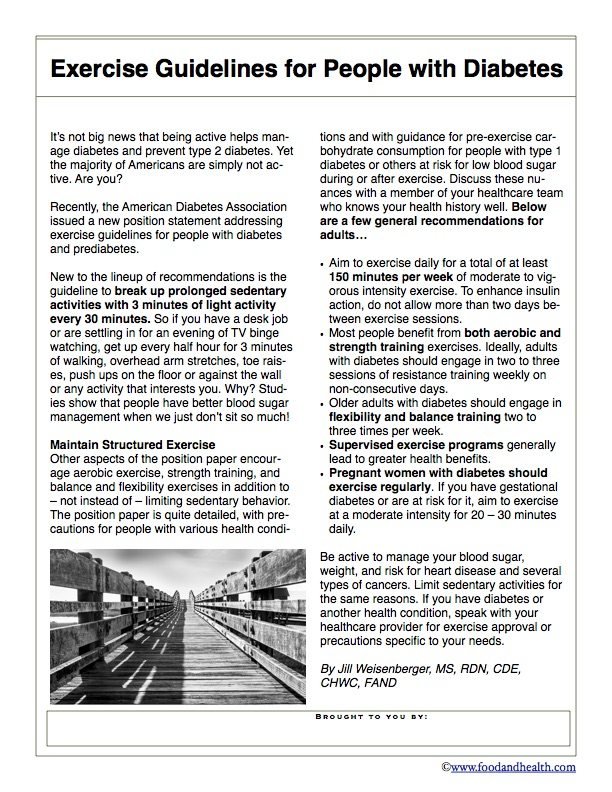Exercise Guidelines for People with Diabetes and Prediabetes
It’s not big news that being active helps manage diabetes and prevent type 2 diabetes. Yet the majority of Americans are simply not active. Are you?Recently, the American Diabetes Association issued a new position statement addressing exercise guidelines for people with diabetes and prediabetes.New to the lineup of recommendations is the guideline to break up prolonged sedentary activities with 3 minutes of light activity every 30 minutes. So if you have a desk job or are settling in for an evening of TV binge watching, get up every half hour for 3 minutes of walking, overhead arm stretches, toe raises, push ups on the floor or against the wall or any activity that interests you. Why? Studies show that people have better blood sugar management when we just don’t sit so much!Maintain Structured ExerciseOther aspects of the position paper encourage aerobic, strength training, balance and flexibility exercises in addition to – not instead of – limiting sedentary behavior. The position paper is quite detailed, with precautions for people with various health conditions and with guidance for pre-exercise carbohydrate consumption for people with type 1 diabetes or others at risk for low blood sugar during or after exercise. Discuss these nuances with a member of your healthcare team who knows your health history well. Below are a few general recommendations for adults:
- Aim to exercise daily for a total of at least 150 minutes per week of moderate to vigorous intensity exercise. To enhance insulin action, do not allow more than two days between exercise sessions.
- Most people benefit from both aerobic and strength training exercises. Ideally, adults with diabetes should engage in two to three sessions of resistance training weekly on non-consecutive days.
- Older adults with diabetes should engage in flexibility and balance training two to three times per week.
- Supervised exercise programs generally lead to greater health benefits.
- Pregnant women with diabetes should exercise regularly. If you have gestational diabetes or are at risk for it, aim to exercise at a moderate intensity for 20 – 30 minutes daily.
Be active to manage your blood sugar, weight and risk for heart disease and several types of cancers. Limit sedentary activities for the same reasons. If you have diabetes or another health condition, speak with your healthcare provider for exercise approval or precautions specific to your needs.By Jill Weisenberger, MS, RDN, CDE, CHWC, FANDSource:
- Sheri R. Colberg, Ronald J. Sigal, Jane E. Yardley, Michael C. Riddell, David W. Dunstan, Paddy C. Dempsey, Edward S. Horton, Kristin Castorino, Deborah F. Tate, Physical Activity/Exercise and Diabetes: A Position Statement of the American Diabetes Association. Diabetes Care Nov 2016, 39 (11) 2065-2079; DOI: 10.2337/dc16-1728



